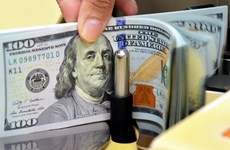Capital flows to government bonds
The English language news website VietNamNet Bridge on April 18 reported
that banks have had to inject their money into government bonds as
credit gets stuck.
The English language news website VietNamNet Bridge on April 18 reported
that banks have had to inject their money into government bonds as
credit gets stuck.
Credit reportedly grew by 0.1 percent by the end of the first quarter in comparison with the end of 2013, while at the same time, deposits grew by 4 percent, according to the State Bank of Vietnam.
While banks can easily mobilise capital from the public, they cannot find borrowers. The economic downturn has caused businesses to scale back their activities, weakening the demand for capital.
The profusion of capital has forced the inter-bank interest rates to drop sharply in the first quarter of the year: 2.8 percent per annum for overnight loans, 3 percent for 1-week and 3.5 percent for 2-week loans. Observers said the sharp interest rate reductions demonstrate the weaker demand for capital from banks, which now can easily raise funds from the public.
The glut of capital also explains why the open market was quiet in the first quarter. No bank registered to attend the bids in the last three consecutive bidding sessions.
Through the OMO (open market operation), the State Bank has taken back 35 trillion VND in cash from circulation.
A report of the State Bank disclosed that 244 trillion VND worth of State Bank bonds was issued in the first quarter. Meanwhile, the matured bonds’ value was 123 trillion VND. This means that the State Bank’s net cash withdrawal through bonds was 121 trillion VND.
Governor of the State Bank Nguyen Van Binh made the noteworthy announcement at the latest government meeting that the central bank bought 7.7 billion USD worth of foreign currencies, equal to 170 trillion VND, in the first quarter.
Buying foreign currencies means “pumping” dong into circulation.
The figures about the cash withdrawal through OMO and bonds in the first quarter, and the sum of dong put into circulation, suggest that the State Bank has successfully managed the money supply. This helps both to avoid inflationary pressures and to improve the country’s foreign currency reserves.
Even though the ceiling deposit interest rate has dropped to six percent from seven, capital keeps flowing into banks. Depositors are those who have idle money but find other investment channels unattractive or unsafe.
Given the continuing inflow, commercial banks have decided to pour their money into bonds. Over 244 trillion VND has been injected into the State Bank’s bonds, though the bond interest rates are not very attractive: 2.6-2.8 percent per annum for 28-day bonds.
Commercial banks have also put money into government bonds, to the tune of about 65 trillion VND. Though the interest rates have reduced, bonds are still attractive to the banks, because the bonds can bring profits and can be converted into capital when necessary.
However, analysts have warned that the State Bank’s bonds and government bonds cannot serve as long term investment channels for banks. The State Bank may cut down the volume of bonds to be issued once it wants to reduce the foreign currency purchases.
At the same time, the amount of government bonds is limited: Vietnam plans to issue 280 trillion VND worth of bonds this year, 30 percent of which has already been issued in the first quarter.-VNA
Credit reportedly grew by 0.1 percent by the end of the first quarter in comparison with the end of 2013, while at the same time, deposits grew by 4 percent, according to the State Bank of Vietnam.
While banks can easily mobilise capital from the public, they cannot find borrowers. The economic downturn has caused businesses to scale back their activities, weakening the demand for capital.
The profusion of capital has forced the inter-bank interest rates to drop sharply in the first quarter of the year: 2.8 percent per annum for overnight loans, 3 percent for 1-week and 3.5 percent for 2-week loans. Observers said the sharp interest rate reductions demonstrate the weaker demand for capital from banks, which now can easily raise funds from the public.
The glut of capital also explains why the open market was quiet in the first quarter. No bank registered to attend the bids in the last three consecutive bidding sessions.
Through the OMO (open market operation), the State Bank has taken back 35 trillion VND in cash from circulation.
A report of the State Bank disclosed that 244 trillion VND worth of State Bank bonds was issued in the first quarter. Meanwhile, the matured bonds’ value was 123 trillion VND. This means that the State Bank’s net cash withdrawal through bonds was 121 trillion VND.
Governor of the State Bank Nguyen Van Binh made the noteworthy announcement at the latest government meeting that the central bank bought 7.7 billion USD worth of foreign currencies, equal to 170 trillion VND, in the first quarter.
Buying foreign currencies means “pumping” dong into circulation.
The figures about the cash withdrawal through OMO and bonds in the first quarter, and the sum of dong put into circulation, suggest that the State Bank has successfully managed the money supply. This helps both to avoid inflationary pressures and to improve the country’s foreign currency reserves.
Even though the ceiling deposit interest rate has dropped to six percent from seven, capital keeps flowing into banks. Depositors are those who have idle money but find other investment channels unattractive or unsafe.
Given the continuing inflow, commercial banks have decided to pour their money into bonds. Over 244 trillion VND has been injected into the State Bank’s bonds, though the bond interest rates are not very attractive: 2.6-2.8 percent per annum for 28-day bonds.
Commercial banks have also put money into government bonds, to the tune of about 65 trillion VND. Though the interest rates have reduced, bonds are still attractive to the banks, because the bonds can bring profits and can be converted into capital when necessary.
However, analysts have warned that the State Bank’s bonds and government bonds cannot serve as long term investment channels for banks. The State Bank may cut down the volume of bonds to be issued once it wants to reduce the foreign currency purchases.
At the same time, the amount of government bonds is limited: Vietnam plans to issue 280 trillion VND worth of bonds this year, 30 percent of which has already been issued in the first quarter.-VNA













